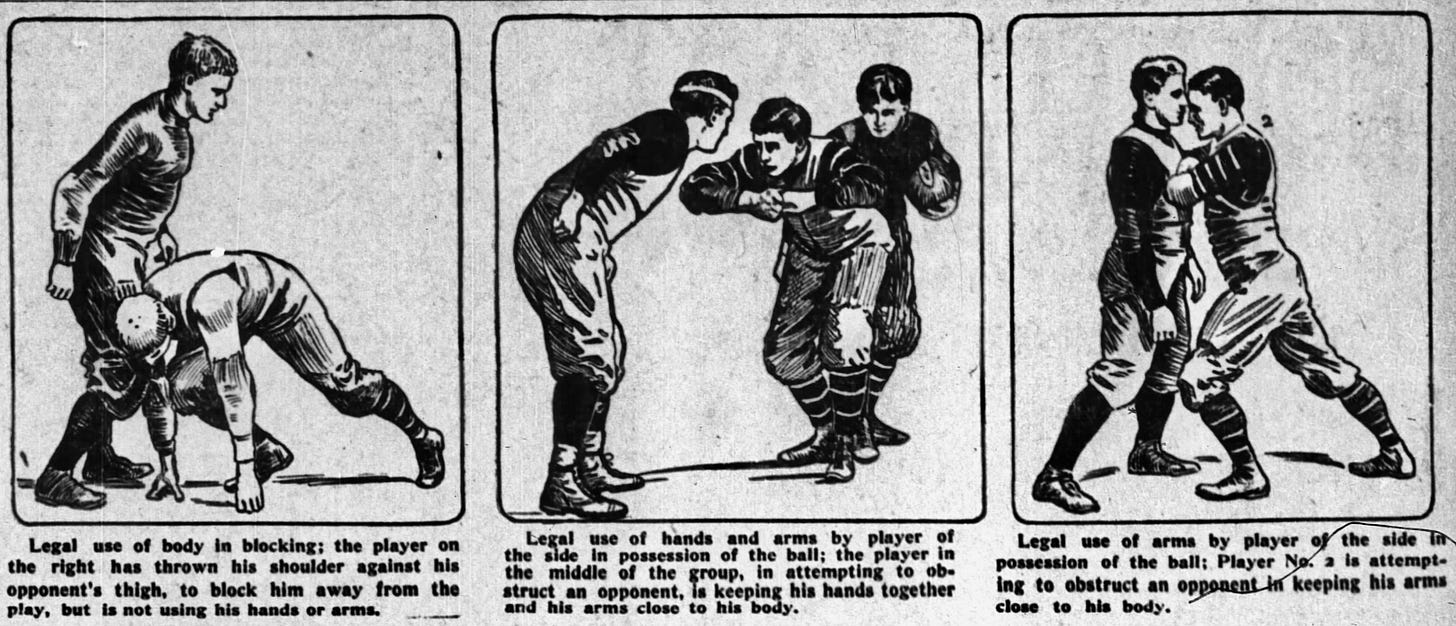Today's Tidbit... Putting Offensive Football On Hold
I haven't posted much lately since I'm working hard to finish my next book, but here's a story from our old friend, Walter Camp. You can find this information in Walter Camp's The Book of Foot-Ball, published in 1910, which you can download for free from the Library of Congress.
The story concerns why football prohibited offensive players from using their arms when blocking for many years. In its early days, football was rugby. Americans adopted England's Rugby Union Rules in 1876, other than a couple of minor tweaks. There were only 61 rules, and some of them were not terribly clear, so they interpreted them to the best of their ability. Even when they understood the rules, they did not always like them, so the American college players started changing them. After enough changes piled up, Americans were no longer playing rugby; it had become a different game.
Some rule changes were more important than others, and a critical one was the American adoption of interference, what we now call blocking. One of rugby's fundamental rules concerned the need for players to remain onside. For the team possessing the ball, a player was offside if he was in front of or closer to the opponent's goal than the ball. Since offside players could not magically teleport themselves behind the ball, the rules said they could not participate in play until they were brought onside by the ball moving in front of them or them moving behind the ball. The onside and offside concept is the fundamental reason rugby does not allow blocking, since you cannot be in front of the ball and participate in play.
The version of rugby played in the 1870s and 1880s involved scrums in which the two teams pushed one another and tried kicking the ball through the other team’s line in the scrum. It did not encourage heeling the ball behind the scrum, picking it up, and running with it, but the latter was the style of play preferred by Americans. So, when we established the system of possession and downs in 1882, that brought the controlled scrimmage in which one team heeled the ball back to a teammate who picked up the ball and lateraled it to a teammate who ran with it.
The problem with that approach was that the moment the offense heeled the ball back and a teammate picked it up, everyone in the front line (known as forwards) immediately became offside. Even worse, to give their teammate a chance to run with the ball, the forwards extended their arms to the side, impeding the other team's attempt to tackle the runner.
Once the offensive forwards extended their arms to the side, it was a quick step to grab and hold members of the other team who tried to break through. That turned into a mess, so the rulemakers had to decide whether to return to rugby of old or to create another rule limiting how offensive players could interfere with defenders. They chose the latter and agreed that offensive players could interference with their bodies, but not with their arms and hands.
For the next 100 years, offensive players could not extend their arms or hold defensive players. Those limits lasted until 1977, when offensive players in college gained the ability to extend their arms when blocking, which especially affected pass blocking techniques. Still, those old restrictions originated in football's early days in one of its first moves away from its rugby origins.
Football Archaeology is reader-supported. Click here to donate a couple of bucks, buy one of my books, or otherwise support the site.




Do you have a tidbit or post with more detail about why hands were eventually allowed away from the body, Tim? And what's the rule now? Anything goes except grabbing with the hands, i.e. holding? What was the penalty call under the old rule, when the arms extended?